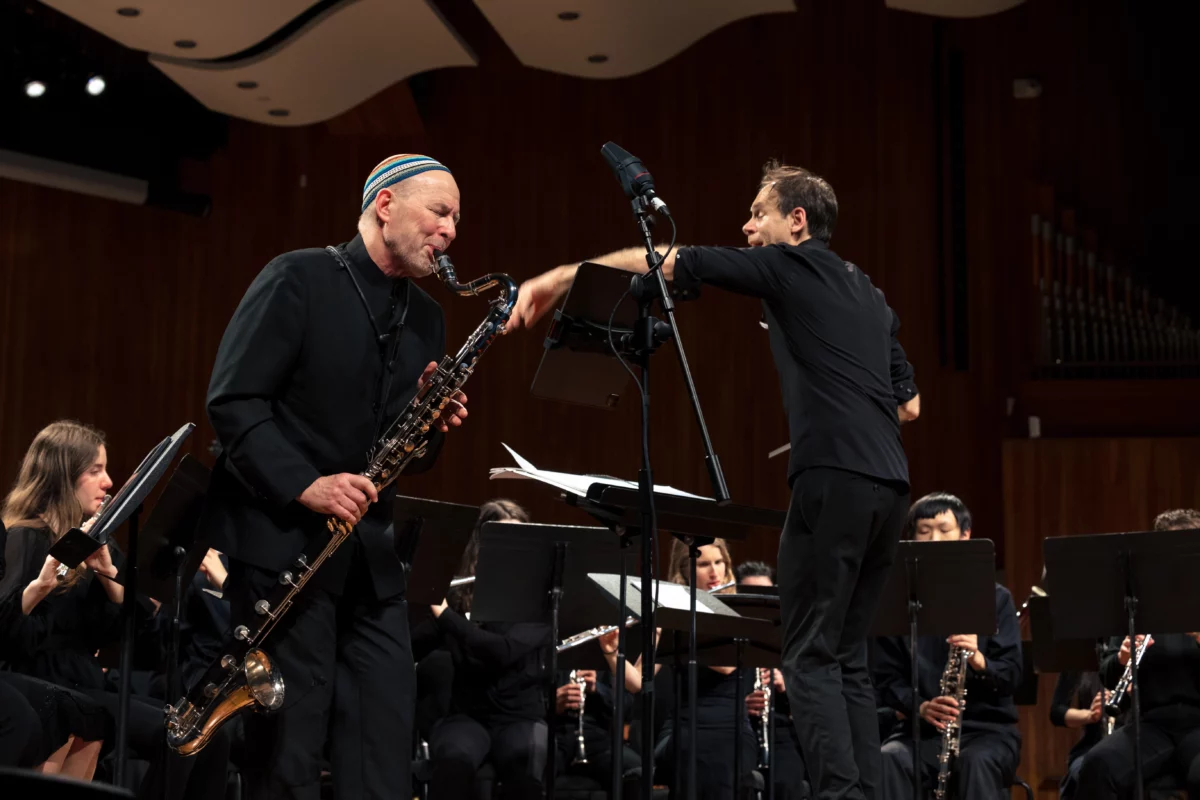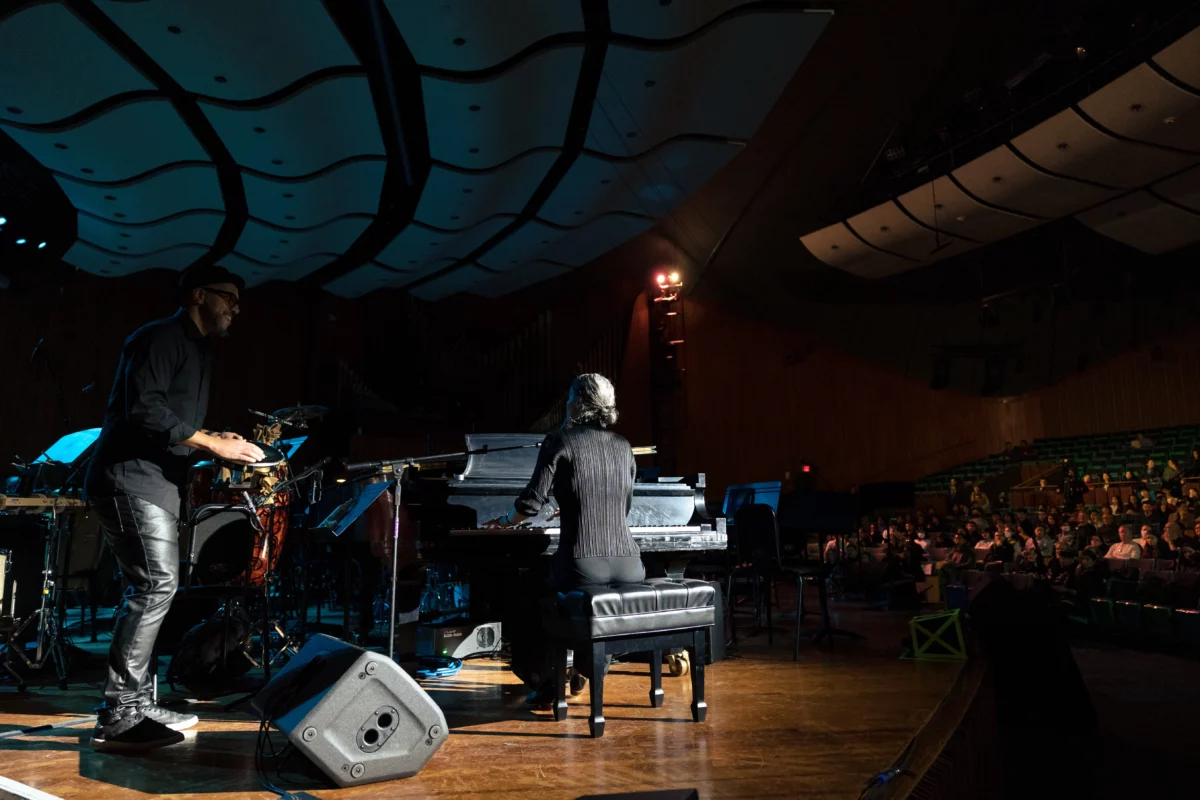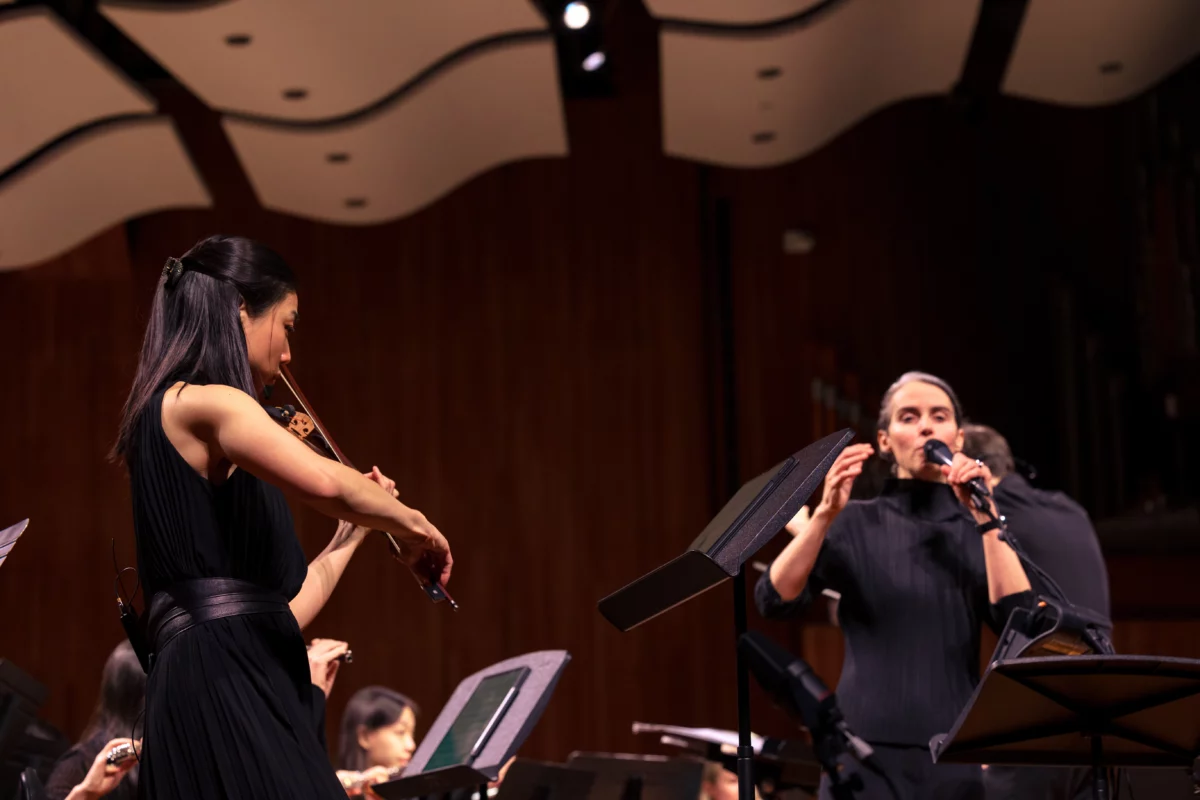Visiting musician Clarice Assad applies her inclusive approach to a new project about the Amazon
The accomplishments of Brazilian-American composer, vocalist, and pianist Clarice Assad are many. She has won accolades, earned prestigious residencies, and her work is performed around the world. Last year, her album “Archetypes,” which she recorded with her father, guitarist Sérgio Assad, and the Third Coast Percussion ensemble, was nominated for two Grammys: Best Chamber Music/Small Ensemble Performance and Best Contemporary Classical Composition categories.
But what makes Assad stand out even further is her inclusive, participation-based approach to music-making. It’s a trait she has been displaying fully as an MIT CAST visiting artist, a two-part residency that built up to the recent world premiere of Assad’s new work, “Amazônia Sem Lei” (“Lawless Amazon”), performed by the MIT Wind Ensemble and violinist Natalie Lin Douglas, an Assistant Professor in Music and Theater Arts. It was part of “Hearing Amazônia—The Responsibility of Existence,” a multi-year project launched in 2021 by Frederick Harris Jr., Director of the Wind and Jazz Ensembles at MIT, that focuses on both the music and ecosystems of Brazil.
For Lin Douglas, the new composition pushed her outside of her usual terrain. “I don’t know if any other piece has been written for voice, violin, and wind ensemble, so it’s kind of a very unique color combination,” she said in a joint video interview with Assad. “I should also say that Clarice’s part is more improvisatory. I’m from a classical tradition so I don’t typically improvise.”
“She’s improvising a little bit,” Assad playfully interjected. “And she’s amazing.”

The composer left more wiggle room for her own contribution. “The music that is not written is maybe indicated, for example ‘Here you’re going to sing effects’—and that’s the improvisation part,” she explained. “I’m just there playing whistles and doing a little vocalese and a little percussion. Natalie’s the soloist and I’m coloring things, doing some interludes. I like the idea of having all of this big massive sound: you hear the wind instruments, you hear violin, and you just hear the voice.”
You will hear the Amazon, too. “There are some sonic things, some of the harmonic language, that are reminiscent of the region—the indigenous people of Brazil include a lot of chants and percussion, so I tried to add some of that,” Assad said.
“Amazônia Sem Lei” was transcribed using traditional notation so the musicians could read it, but before it got to that stage, Assad composed by partly using VOXploration, an interactive system she developed to make music education and notation faster, easier to learn, and thus more accessible to a variety of people. It incorporates geometric shapes and is especially helpful in empowering people to make music as a group.
“When I’m doing workshops and I want everybody to sing the same thing or play the same pattern, it comes in quite handy” Assad said. “It also becomes a way for people to create their own patterns and from there they can go really wild. I’ve seen people take that system and create very complicated notation. Even I was like, ‘How do you do that?’”
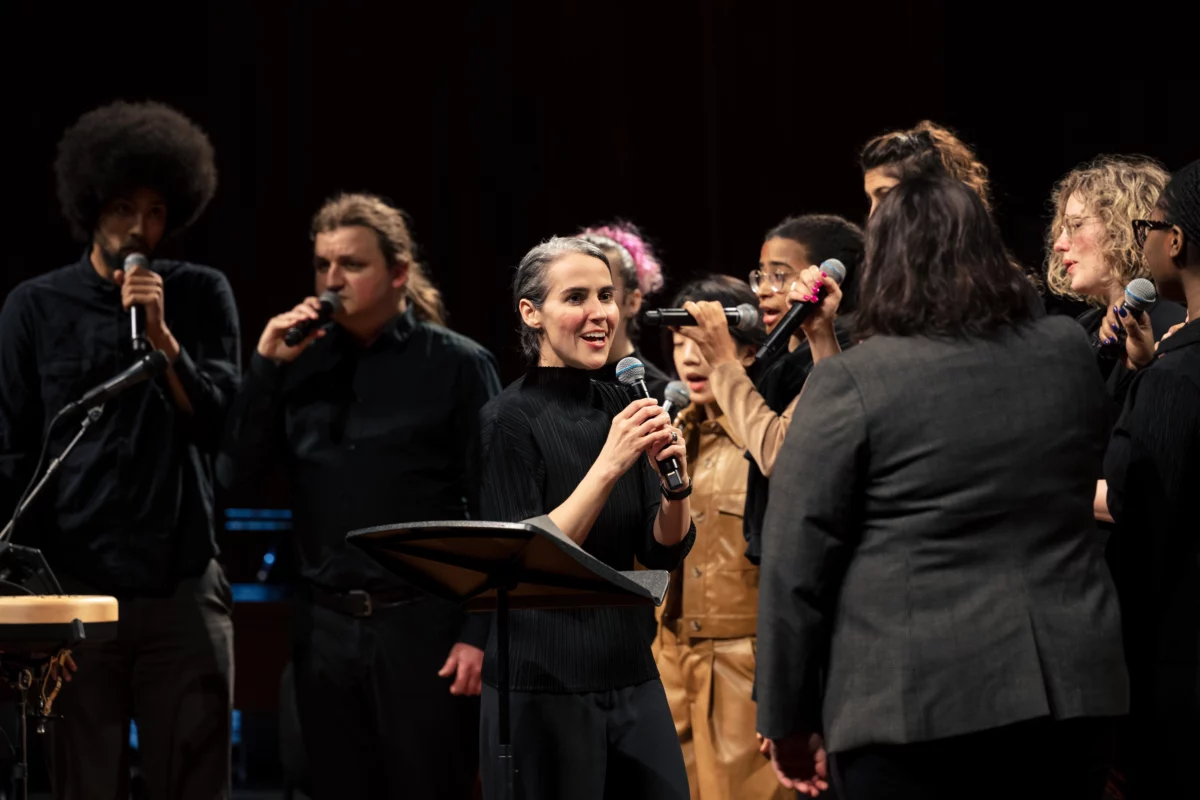
The two first collaborated in 2019, when Assad participated in a Houston concert focused on Brazilian composers with Lin Douglas’s Kinetic ensemble. They remained in touch by video during the pandemic, and Lin Douglas put the wheels in motion for Assad to be a visiting artist at MIT. “We like to play together, apparently,” Assad said, laughing. “We keep finding new ways to do it.”
Part of Assad’s brief as a visiting artist has been to work with MIT students. On her first visit in November 2022, she presented with Lin Douglas, visited classes, and met the Wind Ensemble and the Vocal Jazz Ensemble with whom she would collaborate.
“Fred [Harris] wanted me to improvise with the Wind Ensemble, which is the most classically-oriented one—they don’t really improvise, they read,” Assad said. “They’re a little bit shy trying things so I worked with them with the voice first. I got off the stage and had everybody in small groups and I taught them some techniques that they could use to create their own music. Then we went back on stage and I used the same kinds of gestures and techniques and we did a whole new improvisation, but with their instruments. That was wild! Everybody was singing and improvising and doing rhythms. I thought they were going to look at me like I was an alien, but they did interact.”
Lin Douglas piped in: “She did a similar thing with the Introduction to Composition class, where a lot of the students aren’t musicians at all—this is their first entry into writing music. I love that using the voice evens the playing field: you don’t have to be really skilled at an instrument to participate in improvisation. You can be like, ‘This is just a game, anyone can do it, and you don’t have to be a serious musician to participate.’”
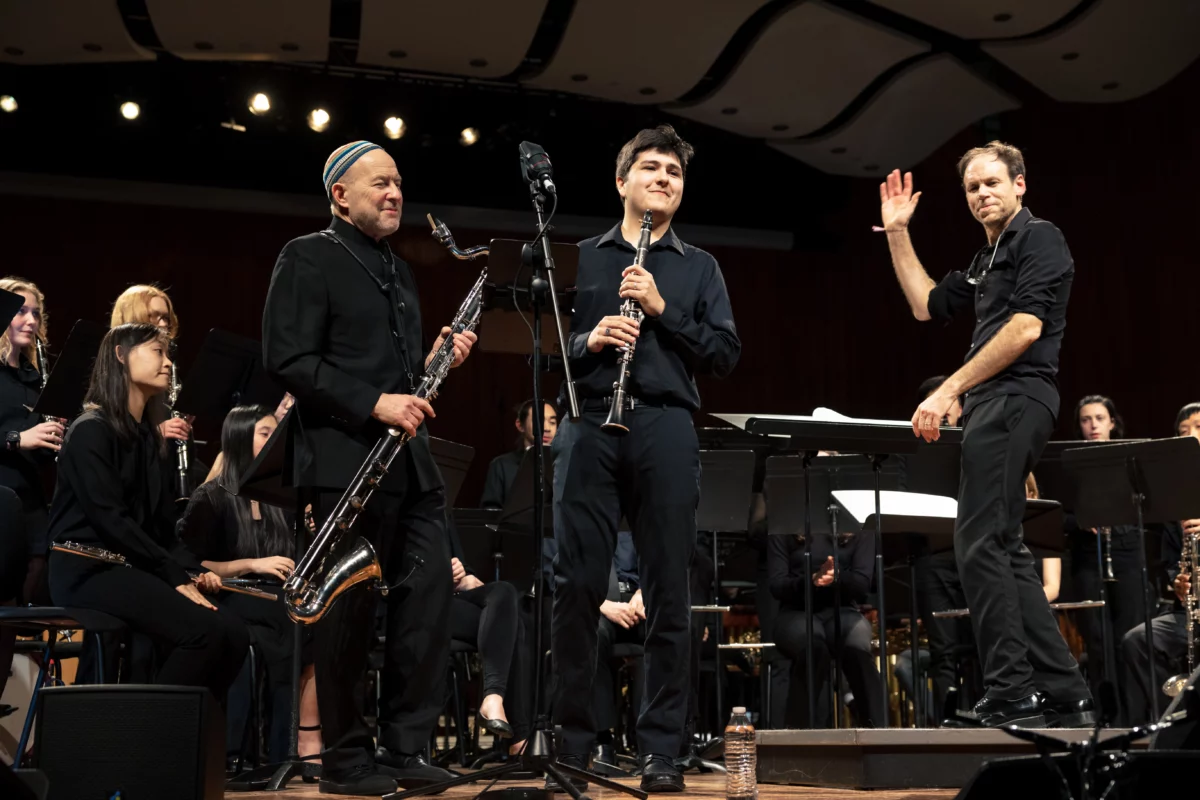
The MIT musical community was well represented at the concert, which, in addition to Assad’s piece, also included performances of Antônio Carlos Jobim’s “Passarim,” Hermeto Pascoal’s “Hermanos Latinos,” Chiquinha Gonzaga’s “Corta Jaca,” and Evan Ziporyn’s “Drill.” The Brazilian experience will continue at the end of March when over 70 students travel to the Amazonian city of Manaus to perform another CAST commission.
Naturally, Lin Douglas had left Assad free to come up with whatever she wanted for her MIT piece. But that her residency happened to coincide with the “Hearing Amazônia” series was a challenge the composer could not turn down.
“There’s a lot of problems going on, as we know, with the Amazon, and there has been for a long time,” Assad said. “So when they were talking about doing this project, at first I was scared but because of the things that are happening, but also I was excited about it. This piece is really about hope,” she continued. “Not ‘it’s going to be a happy end,’ but hope it will bring more awareness and with more attention to what needs to be done.”
Watch a recording of the concert: https://web.mit.edu/webcast/mta/s23/2/
Written by Elisabeth Vincentelli
Editorial direction by Leah Talatinian


